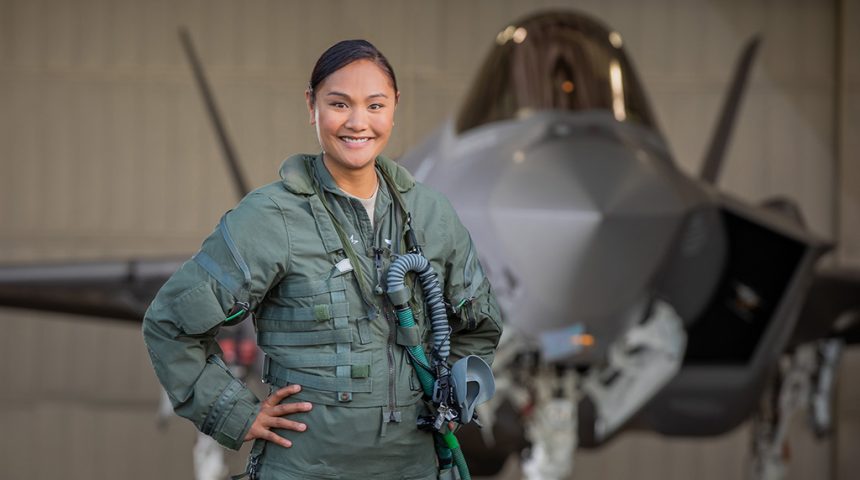We talked about the F-35’s current and future capabilities; differences with the F-16 in the SEAD and CAS missions; and much more, with Lockheed Martin’s test pilot Monessa “Siren” Balzhiser.
Graduated from the United States Air Force Academy in 2004, Monessa Balzhiser is the first female production and training pilot for Lockheed Martin, flying both the F-35 and F-16 aircraft. She joined Lockheed Martin in 2018, after 12 years as an officer and F-16 Instructor Pilot in the U.S. Air Force and 1,800 flight hours (including 320 in combat) under her belt. In her current position, among many other things, she flies the F-35 for production support and acceptance flights and also provides programmatic and technical support for all F-16 and F-35 related airworthiness and mission readiness standards.
We had the chance to meet and interview “Siren” at Pratica di Mare Air Base, during the Italian Air Force’s 100th Anniversary airshow, to learn more about her job and the F-35.
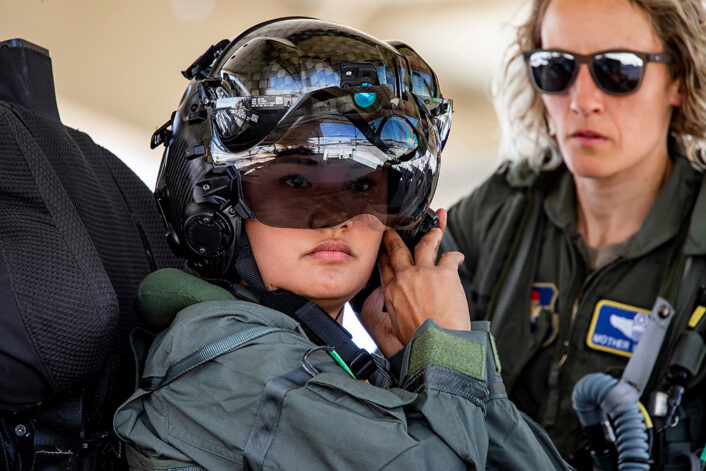
Monessa, can you tell us what’s the role of an F-35 test pilot?
As Lockheed Martin F-35 test pilot we perform a variety of tasks for the Company, but our main job involves being the first person to fly the jet once it comes out the production line. We test both the vehicle systems, which includes the power generation, the cooling system, flight controls, gear, as well as the mission systems, which includes displays, sensors and weapons, to ensure that the F-35 is safe and that we are producing a quality system before actually signing off the jet or handing it to our government counterparts to buy off the jet.
In addition to flying the F-35, a lot of the F-35 company pilots also help in other locations, as besides Fort Worth, we also have production lines in Italy and Japan. And we assist with a lot of the engineering solutions and airworthy requirements for multiple business areas depending on what the customer needs are.
Considering that the aircraft is now in service with many nations and has also grown some combat experience, what kind of testing is required on the platform?
As to the aircraft being now in service and having grown some combat experience, I can say that, as we reach the 1000th F-35 to be delivered, Lockheed Martin is constantly looking for ways to improve the jet. We’re continuing to see threats evolve at a rapid pace, so innovating to equip the F-35 with the latest and most advanced capabilities is really critical to staying ahead of those threats. And any kind of type of testing that’s required on that platform is done to improve a lot of what is already a capable system.
Some of the recent tests include weapons integration, upgrades, sensors and capabilities specific to Technology Refresh 3, or TR3, aimed at ensuring that the F-35 can guarantee security through the 21st century. We’re constantly working for the aircraft to remain relevant not only for today’s fight, but also for future fights to come.
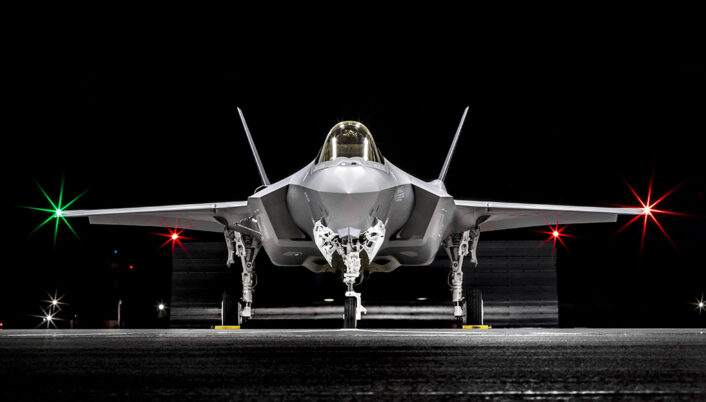
In your opinion, how much of the F-35’s potential are we seeing/using so far? Are we still far away from unlocking its full potential?
In my opinion, I do think we are using the F-35 to its incredible full potential, but that really does depend on how each country is utilizing the jet the way it needs to be for the security and deterrence of the threats that our customers are facing.
I no longer fly operationally, but I have talked with multiple F-35 pilots and customers. They are very amazed at what this jet can do already. And now with TR3 coming up, for those customers that are getting that refresh, the F-35 potential is just going to continue to grow. So yes, we are continuing maximizing the capabilities of the F-35 and I do not think we’re a long way away from unlocking its full potential.
From a test pilot point of view, what are the main differences between the three F-35 variants? How noticeable are the differences between the three variants in terms of handling, performance, etc?
The main differences between the F-35 variants – the A, the B and the C – are mostly seen with the vehicle systems of the jet. A lot of the mission systems inside the jet, including what we see just looking inside the cockpit, with the exception of very few switches, are quite the same from the pilot’s point of view.
Some of the vehicle system differences include, for example, that the A and C model do carry more fuel than the B model. Therefore, they have a longer range capability. The range is greater than about 1200 nautical miles for the A and the C model with internal fuel, while the B model does greater than about 900 miles. Also, the A model is the only variant with an internal gun. However, we can use external guns with the other variants. The and the C model do have a larger weapons payload of 18,000 pounds, while the B model can only really carry 15,000 pounds.
In terms of flying, I only fly the A model, so talking with the other pilots who are qualified in all three variants, there are very minor differences when it comes to handling, but performance-wise they all have the same capabilities. Obviously the one thing that is noticeable when dealing with the A, the B and the C variants is that while the A is our most prevalent jet that’s used out there, the B model is the one that can hoover and the C model has 8 foot wingspan, larger than the A and the B. So, from a performance standpoint and a handling standpoint, the C model generally does a little bit better from glide ratio just because it has longer, larger wings.
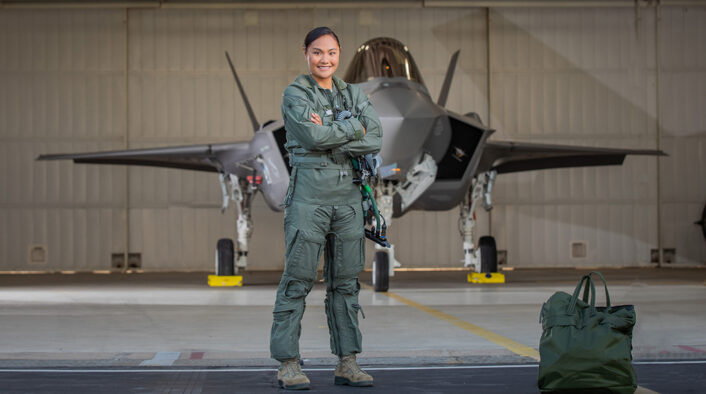
We often talk about datalinks, AI, Machine Learning, human-machine interface when we analyse the F-35, is there any knowledge in the fields of Information Technology required to fly and test the F-35 compared to previous generation aircraft?
Pilots are not required to have specific knowledge in the fields of Information Technology (IT) before flying or testing the F-35 with regards to datalink, AI, Machine learning, or Human-Machine interface. When the F-35 has an upgrade or update in the systems involving IT, the pilots work closely with our Flight Test group and engineers to ensure we are prepared with the background information and necessary checklists needed to test the systems. We have also seen successful integration of “AI-like” upgrades, such as Automated Ground Collision Avoidance System (AGCAS), over multiple Lockheed Martin platforms. AGCAS started in the F-16 and proved to be critical to saving pilots’ lives leading to the integration of AGCAS into the F-35 earlier than scheduled. We are continuing to integrate new technologies and capabilities into the F-35 to outpace emerging threats, and pilots are constantly collaborating with the engineers and developers to ensure a safe and effective product.
Can you explain something about the F-35’s EW/ESM capabilities compared to 4th gen platforms? Are they enough to undertake the SEAD mission and where we are at with the integration of the AARGM-ER?
The F-35 EW capability, electronic warfare capability, is a key function enabling pilots to operate using sensor fusion. The F-35’s advanced sensor suite, which compared to the F-16 is much more advanced because of how sensor fusion integrates in the electronic warfare system, allows the F-35 to locate and track enemy forces jam radars and really disrupt attacks. Moreover, it gives pilots that 360 degree missile warning capability in a very accurate high fidelity way using sensor fusion in combination with the DAS system, or the Distributed Aperture System.
When comparing the F-35 to flying 4th generation aircraft, obviously stealth plays a big part, it really is one of the big features of fifth generation capability, but it also plays a big part in EW.
As to the SEAD mission and the integration of the AARGM-ER, many pilots have mentioned that tactics for SEAD missions are changing just because of what the F-35 is able to do. It can go farther into threatened locations where 4th generation aircraft could not. So that is a big enhancement and a big tactical change in mindset for how some of the customers that we have talked to are using this aircraft in some of the SEAD missions. Thanks to the integration and interoperability with 4th generation aircraft, the 5th generation aircraft can enhance the legacy aircraft capabilities by passing the data that they are able to get into areas where 4th generation aircraft cannot.
Author: On this topic, Lockheed Martin has also provided me an official statement: “The F-35’s advanced Electronic Warfare (EW) & Electronic Support Measures (ESM) allow it to geolocate and target threats using its sensor suites, whereas 4th Generation aircraft use radar warning receivers that cannot provide enough detail to engage the threat. The F-35’s EW and ESM capabilities, combined with its low observability and integrated data fusion, make it uniquely qualified to execute the SEAD mission in the dense threat environment of a near-peer adversary. We are integrating AARGM-ER as part of the Block 4 program to further enhance the ability to execute SEAD missions.”
Can you briefly explain how is a CAS sortie flown by the F-35 different from one flown by the Viper? Has the F-35 provided the opportunity to “unlock” a new CAS doctrine? And what about other mission types?
Objectively, you have the same strategic mission objectives going out for Close Air Support, but it is slightly different between the F-35 and the F-16. A lot of the CAS missions that I have previously flown in combat with the F-16 were in very low threat environments, no air-to-air type of threats or aircraft flying near us. So we focused mainly on just air-to-ground tactics. And what the F-35 provides, as I had previously mentioned, is that while it can still do a lot of the air-to-ground tactics that a F-16 will do with respect to close air support, now we are also able to do that in higher threat locations based off the rules of engagement and obviously this is what the customer wants to do with the F-35 when it comes to the closer support doctrine.
As to the opportunity to unlock a new CAS doctrine, I’d have to say that would be dependent on our customers and how they operationally do the mission for close air support and what they’re utilizing the jet for. As I mentioned, the F-35’s capabilities allow them to do a lot more things than legacy aircraft in high threat locations, primarily because of its stealth and sensor fusion and advanced sensor suites, as well as internal weapons. Whether they’re changing their CAS doctrine or not is up to the country and our customers. However, the F-35’s capability is definitely higher than what I previously flew in the F-16.
Obviously there’s other mission types that each customer is using the F-35 for both in an offensive and defensive type of tactical solution. We are seeing the F-35 being maximized to its potential of the capabilities it can offer; its Stealth capability, the High Fidelity data information that’s being sent out not only to other F-35s, but all across various bases in the battlefield to include air, land, sea, space, and cyber. It is becoming a critical node able to affect various types of missions, and that’s where I can see the F-35 really changing tactics and providing a new opportunity to unlock certain doctrines.
Given your experience flying the F-35 and the F-16, has the myth that the F-35 is a poor dogfighter been busted? Do you think there’s still room for improvement in that field? And in the end, is it even required considering the overall capabilities of the aircraft?
For my experience with flying the F-35 and the F-16, I do believe that myth has been busted. Something that I really found surprising when flying the F-35 is its incredible ability to maneuver at slower airspeeds than I would have with the F-16.
The advanced flight controls, as well as its large horizontal stabilizers in the back, enable it to really just fly at slower speeds and have full capability of the flight controls to maneuver the nose in ways and direction that I was never able to do with the F-16. I think this is a great capability and a testament to the maneuverability of the F-35.
The F-16 likes to go faster or optimize its turn weight, so it’s a different type of dogfighting, but that doesn’t mean that the F-35 cannot dogfight… I’ve been astonished at how this jet can maneuver especially at low speeds.
If you ask me if there’s room for improvement in that field, in all honesty, I say it really depends on how our customers are going to use the F-35.
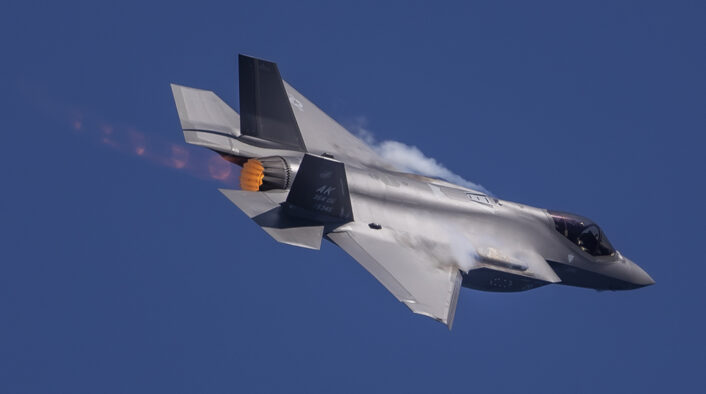
In the end, the F-35 is really there to maximize stealth, to maximize data link and sensor fusion, and providing that data out to the rest of the battlefield. It’s highly maneuverable and can dogfight. It can fly really far out beyond visual range gathering data and inserting itself into high threat areas, where low observability is key in survivability, as well as lethality, and is able to employ weapons where needed and where previous 4th generation fighters were not able to.

